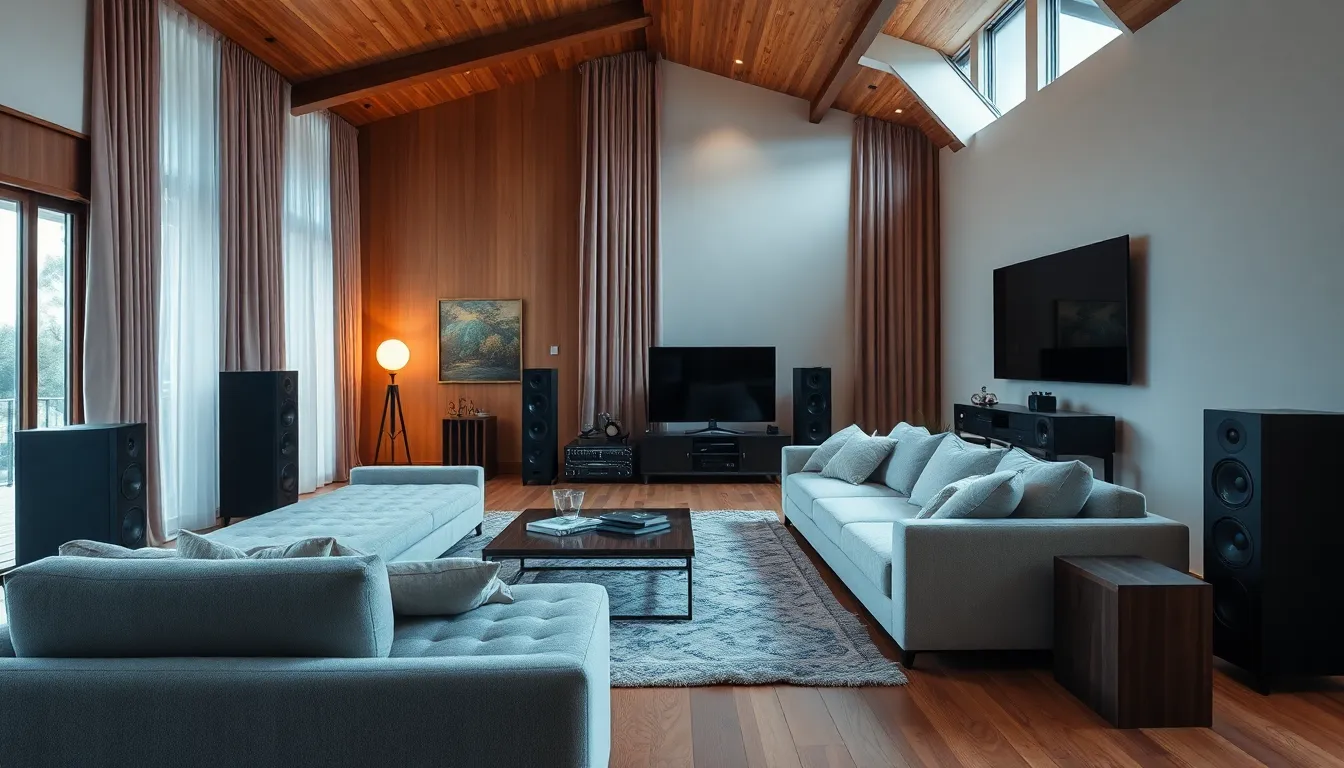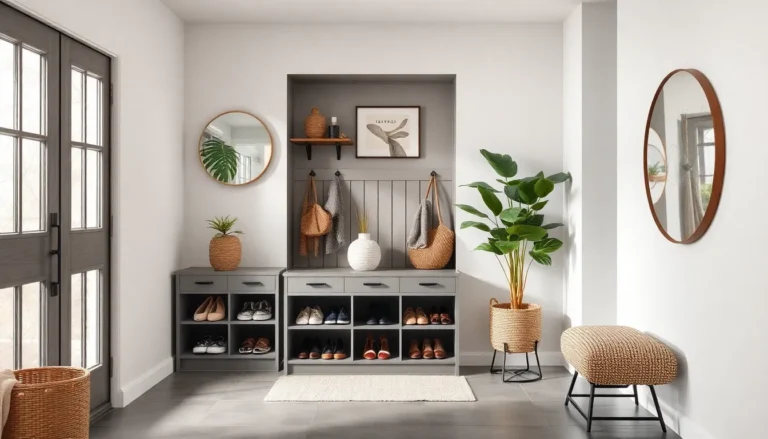Imagine cranking up your favorite tunes only to realize your music system sounds like it’s trapped in a tin can. The secret to a killer audio experience isn’t just in the speakers; it’s all about placement. Whether you’re hosting a dance party or enjoying a solo jam session, the right setup can transform your space into a concert hall or a cozy café.
Table of Contents
ToggleImportance Of Music System Placement
Music system placement plays a crucial role in sound quality and overall experience. Placement determines how sound waves interact with a room’s acoustics, affecting clarity and balance. Strategic positioning maximizes audio output, enhancing bass response and eliminating dead spots.
Listeners notice the difference in soundstage when speakers are arranged correctly. Positioning speakers at ear level creates an immersive experience, allowing for clearer dialogue in films and richer vocals in music. Conversely, poor placement can muddle frequencies and lead to listener fatigue.
Spatial awareness is vital when planning speaker arrangements. Corner placement boosts bass but can lead to uneven sound distribution. Centering speakers along the front wall typically offers better imaging. For surround systems, placing speakers at optimal angles ensures a dignified, encompassing sound experience.
Furniture and room layout also influence sound perception. Soft furnishings absorb sound, leading to a cozy environment but sometimes dulling clarity. Reflective surfaces, such as hard walls, can create echoes that distort audio. Balancing these elements contributes significantly to the listening experience.
Acoustic treatment further enhances the benefits of proper placement. Adding sound panels, carpets, or drapes can help control sound reflections, leading to a clearer audio experience. Utilizing these techniques can transform an ordinary area into a sanctuary for music lovers.
Investing time in precise placement yields considerable rewards. A well-placed music system amplifies enjoyment and ensures an engaging atmosphere, whether for social gatherings or personal listening. Prioritizing placement cannot be underestimated in creating an optimal auditory environment.
Factors To Consider For Effective Placement

Effective placement of a music system involves several key factors that influence sound quality and overall experience.
Room Size And Shape
Room dimensions significantly impact sound distribution. Larger rooms may require additional speakers to fill the space adequately, while smaller rooms can benefit from fewer, more strategically placed speakers. L-shape or irregularly shaped rooms may create sound distortion due to reflection and absorption. Ensuring that speakers are positioned away from walls helps reduce these issues. Distances between speakers and listening positions also affect clarity. Audiophiles often recommend keeping speakers at least one foot from walls for better performance.
Acoustic Considerations
Acoustic properties of the room can’t be ignored. Hard surfaces, such as tile or glass, can create echoes that muddle sound quality. In contrast, soft furnishings, including carpets and curtains, absorb sound and promote a warm audio environment. Evaluating these materials helps in creating a balanced sound profile. Implementing acoustic panels can further enhance clarity by minimizing reflection. Identifying sound dead zones allows for adjustments in speaker positioning to achieve optimal performance.
Furniture Arrangement
Furniture placement affects sound perception directly. Sofas and chairs positioned close to speakers can obstruct sound waves, distorting audio quality. Open spaces around speakers allow sound to disperse evenly throughout the room. Avoiding clutter near speakers helps maintain audio integrity. As a general rule, listeners should arrange seating in a semi-circle facing the speakers for the best auditory experience. Additionally, adjusting furniture placements during testing can reveal insights into improving sound quality.
Ideal Music System Placement Strategies
Proper music system placement is vital for optimal audio experiences. Following specific strategies maximizes sound quality and enhances enjoyment.
Speaker Positioning
Positioning speakers at ear level enhances clarity in sound. Ideally, alignment should direct sound toward the listening area, creating a balanced audio experience. For stereo setups, speakers should form an equilateral triangle with the listening position. Likewise, surround sound setups require angled arrangements that envelop the listener for immersive experiences. Avoid placing speakers too close together to prevent muddled audio. Partnering speakers with appropriate stands can elevate their efficiency. Ultimately, meticulous speaker positioning contributes significantly to soundstage and overall enjoyment.
Distance From Walls
Maintaining distance from walls improves sound quality. Speakers placed too close to walls can lead to undesirable bass buildup, causing audio distortion. Aim for at least 12 inches of space to allow sound waves to develop freely. This distance minimizes reflections that may muddy the listening experience. Additionally, keeping speakers away from corners generally provides a more balanced sound profile. For larger rooms, increased distance can enhance clarity further. Deciding on the right placement ensures both quality sound and optimal room acoustics.
Common Mistakes In Music System Placement
Correcting common mistakes in music system placement can significantly improve sound quality. Two frequent errors include overlooking acoustic treatment and inadequate wiring management.
Overlooking Acoustic Treatment
Ignoring acoustic treatment often leads to poor sound quality. Hard surfaces reflect sound waves, causing echoes and muddiness. Without proper sound panels, carpets, or curtains, audio clarity suffers. Many people fail to account for this, resulting in uneven sound distribution. Considering acoustic elements while arranging speakers creates a more balanced experience. Prioritizing treatments in small and large rooms enhances clarity and richness. Placing soft furnishings can absorb unwanted sounds, leading to a cozier atmosphere. In contrast, reflective materials can distort sound, affecting overall enjoyment.
Inadequate Wiring Management
Neglecting wiring management leads to a cluttered setup and can affect sound performance. Cables in disarray not only create safety hazards but can also cause sound interference. Individuals often underestimate the impact of organized wiring, which can improve aesthetics and facilitate airflow. Keeping wires out of sight enhances the overall look of a music system. Using cable ties or channels simplifies the organization, ensuring a neat appearance. Properly managing cables promotes longevity and reliability for audio equipment. Prioritizing clean wiring reduces distractions and enhances the immersive experience while listening or watching films.
Achieving the best sound experience hinges on thoughtful music system placement. By strategically arranging speakers and considering room acoustics, one can unlock the full potential of their audio setup. This attention to detail not only enhances sound quality but also transforms the overall atmosphere of any space.
Investing time in proper positioning and addressing common pitfalls can lead to a more enjoyable listening experience. With the right approach to placement and acoustic treatment, anyone can create a captivating audio environment that resonates beautifully with their preferences.



